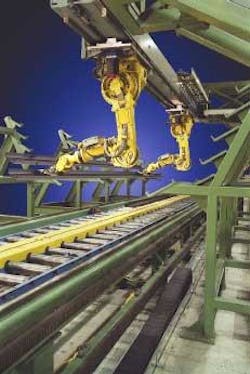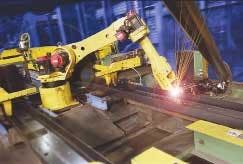Flexible robotic cutting
UPF, Inc. (Flint, MI) supplies thousands of frames to its truck and bus customers each year. A key to the company's success is the ability to deliver variable batch runs of many different frame configurations. Though a competitive advantage, the complicated production process prompted UPF to design a state-of-the-art facility that incorporates a wide range of automation solutions to meet the needs of customers who are provided as few as eight hours notice of a batch-run order for frame rails.
Frame and stiffener rails have cutouts (round, square, or rectangular holes) located in one, two, or all three sides. These cutouts are used to attach other assemblies, including cross-frames, or to route utilities for the vehicle, such as fuel hoses, electrical cables, hydraulic lines, etc. Truck and bus frame and stiffener rails vary in length from eight to more than 40 feet, and weigh 200 to 900 pounds each. A successful automation solution is critical to handle this extreme range, especially with little or no time allowed for changeover.
UPF, along with two of its integrators, Citation Tool (Fraser, MI) and Custom Machines (Adrian, MI), designed and built a robotic automation system that incorporates two state-of-the-art robotic laser-cutting cells and two heavy-payload material handling articulated gantries. The laser-cutting robots use a patented, FANUC shape-generation software package. The articulated gantries use a patent-pending approach whereby a single robot controller drives two independent robot arms to function as a giant reconfigurable gripper.
The automation system consists of two parallel lines, which converge into a single manual frame assembly line. The parallel automation lines provide UPF with the flexibility to manufacture completely different frame rails on each line, or to increase throughput with the same type of rail on both lines.
Both automation lines begin with large CNC punch presses fed by servo-driven pullers. The punch-press indexing slide punch and button holders are pre-loaded with the multiple hole sizes to be punched in the frame rail. A blank frame rail or stiffener rail is attached to the servo-puller, which positions the rail lengthways within the press.
After leaving the press, the servo-puller delivers the rail to an ARC Mate 120iB laser-cutting robot from FANUC Robotics America, Inc. (Rochester Hills, MI.) FANUC Robotics' ShapeGen software is used to program the ARC Mate 120iB to cut predetermined holes or shapes through the vertical sides of the rail using a CO2 laser. The servo-puller accurately positions the rail in the X-axis in the laser cell, and the robot positions the laser head in the Z and Y axes for hole location accuracy.
The rail is then conveyed into an automated material handling area where it can pass through to the frame assembly area, if no further processing is required and/or no rails currently are downstream. Or the rail can be stored temporarily on a storage rack, when a partially assembled frame rail is still present in the downstream frame assembly area, or there is no room to receive rails from the laser-cutting cell. If the rail were to remain on the conveyor, it would act as a roadblock to all upstream laser cutting, and eventually to the punch press. To prevent this roadblock, a FANUC dual-arm Toploader (articulated gantry) robot, consisting of two robot arms mounted to the same overhead linear track, removes the rail from the conveyor and automatically places it onto a storage rack. This process allows the laser and punch-press operations to continue without interruption. Then, when the frame assembly area can accept a new rail, the dual-arm Toploader takes a rail from the storage rack, using first-in, first-out logic, and places it onto a conveyor to assembly.
Alternately, the frame rail might require that a stiffener rail be added to the main frame rail. These stiffener rails are matched to a particular frame rail (they receive the same punch-press and laser-cutting process). An additional complication is that the frame and stiffener rails come in left- and righthanded variations (an assembled truck or bus frame has one lefthand and one righthand frame rail connected by smaller cross-frames). To ensure they are combined with the correct frame rail, the stiffener rails are manufactured just after the matching frame rails—the robot must then match the appropriate rails to one another. When the frame and stiffener rails arrive in the material-handling area, the robots match and combine the left- and righthand rails and stiffeners. Simultaneously, the robots align the various holes and shapes in the frame rail with the matching holes and shapes in the stiffener rail.
System detail
To reduce expensive work in process (WIP), UPF stocks only blank frame and stiffener rails. After receipt of an order, the appropriate frame rail is manually loaded onto a conveyor in front of one of the two punch presses, and connected to a linear servo-puller. The C-shaped frame rails are positioned on the conveyor where through-hole shapes are then stamped by the CNC punch press coordinated by a PLC to guarantee accurate and repeatable hole locations.
The servo-puller removes the rail from the punch press and moves it down to the CO2 laser-cutting cell where various shapes are cut through the vertical "sides" of the frame and stiffener rails. The robot controller, running FANUC Robotics' patented ShapeGen software, makes a two-step laser cut on the rail—one to remove the paint along the path of the desired cut and the second to produce the desired shape. This software gives the robot programmer a choice of predetermined shapes (circle, hexagon, rectangle, slot, keyhole, or pommel), or he can easily configure a custom shape. As the rail is removed from the laser-cutting cell, it is pulled through a brush to remove any small metal particles created by the cutting process. Once the laser cutting is complete, the servo-puller releases the rail onto a conveyor for delivery to the robots.
If the rail does not require any additional processing and the downstream frame assembly area is clear, the rail is conveyed straight through to the assembly area. If the frame rail has to be buffered to one of the eight adjacent storage areas or combined with a stiffener, a FANUC Robotics R-2000iA/200T dual-arm Toploader robot is pressed into action. Each robot is capable of a payload of up to 440 pounds and is equipped with electromagnetic grippers, providing up to 16,000 pounds of lifting force in a simple, lightweight package. Short rails (less than 15 feet long) are light enough to be lifted from the conveyor by a single robot. However, long rails (in excess of 15 feet long) are too heavy and cause excessive wrist loading to be handled by a single robot.
When a long rail enters the work envelope of the dual-arm R-2000iA/200T, one or both robots change position along the linear rail to ensure each robot arm shares the load equally. The position of a robot arm, relative to the second robot arm and to the rail to be picked, varies considerably with each unique rail length—this "on-the-fly" adjustment is servo-controlled, meaning future rails of unknown lengths can be added at any time.
Once the two robot arms are positioned correctly along the rail, they move down and pick up the rail using the electromagnetic grippers. The rail is then either moved to the buffer location (one of eight rack storage areas) or, in a series of pick-place motions, combined with a stiffener rail. A rail stored in the buffer location will be removed by the dual-arm Toploader and placed on the outbound conveyor when the downstream frame assembly area becomes clear.
UPF has realized many short- and long-term benefits and advantages in applying the automated robotic laser cutting and heavy-part material handling system. Among them are the ability to produce and ship complete frame rails with minimal advance, the elimination of storage of expensive partially processed rails, the flexibility to handle a large number of frame and stiffener rails with little or no changeover, and the opportunity to process new rail designs through simple reprogramming of multiple servo-controlled devices including CNC punch press, servo-puller, and FANUC ARC Mate 120iB and dual-arm R-2000iA/200T Toploader robots.
When production at a major automotive company was threatened by the failure of one of its Tier One suppliers, the company assigned BBK, Ltd. (Southfield, MI) to move in and take over the troubled supplier's operations top to bottom. BBK has an extensive history of helping the automotive sector in process capability by enhancing or redesigning production lines and stabilizing quality in ways that not only have preserved and enhanced the profitability of the individual business, but also have protected the ongoing relationships of the OEMs, the Tier Ones, and their subsuppliers.
"The laser cells gave us the flexibility to run multiple numbers of programs, and made us process-capable in terms of quality standards," says Steve Williams, senior director, BBK, Ltd. "Previously, we combined plasma cutting and manual drilling for this operation. Since we implemented the new FANUC robotic laser cutting system, we've been able to increase throughput, eliminate overtime, and improve the safety conditions of that work cell.
"In addition, the overhead robots provided a safer work environment, higher throughput, and reduced work in process," adds Williams.
Ian Orr is Toploader program manager & senior engineer, FANUC Robotics America, Inc.


